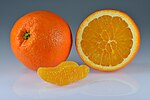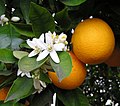Psyllidae, the jumping plant lice or psyllids, are a family of small plant-feeding insects that tend to be very host-specific, i.e. each plant-louse species...
10 KB (1,000 words) - 06:34, 6 April 2024
Diaphorina citri (redirect from Asian citrus psyllid)
Diaphorina citri, the Asian citrus psyllid, is a sap-sucking, hemipteran bug now in the taxonomic family Psyllidae. It is one of two confirmed vectors...
30 KB (3,361 words) - 15:41, 1 September 2024
citrus psyllid. The psyllid was previously introduced into Florida in 1998. Prior to 1998 citrus greening was unknown in the state, thus the psyllids spread...
24 KB (2,579 words) - 14:52, 8 October 2024
Trioza adventicia (redirect from Eugenia psyllid)
Trioza adventicia, commonly known as the syzygium leaf psyllid, lillypilly psyllid, or eugenia psyllid, is a sap-sucking hemipteran bug in the family Triozidae...
3 KB (259 words) - 20:10, 22 June 2024
The disease is transmitted by the Asian citrus psyllid, Diaphorina citri, and the African citrus psyllid, Trioza erytreae. It has no known cure. It is...
32 KB (3,251 words) - 10:55, 21 October 2024
Bactericera cockerelli (redirect from Potato psyllid)
Bactericera cockerelli, also known as the potato psyllid, is a species of psyllid native to southern North America. Its range extends from Central America...
3 KB (395 words) - 15:31, 14 August 2024
Aphalara itadori (redirect from Japanese knotweed psyllid)
Aphalara itadori, the Japanese knotweed psyllid, is a species of psyllid from Japan which feeds on Japanese knotweed (Reynoutria japonica). The UK Government...
7 KB (793 words) - 00:36, 14 June 2024
49% over 2008. The disease is spread primarily by psyllid plant lice such as the Asian citrus psyllid (Diaphorina citri Kuwayama), an efficient vector...
62 KB (6,177 words) - 10:52, 20 October 2024
Psylla buxi (redirect from Boxwood psyllid)
Psylla buxi, known generally as the boxwood psyllid or box sucker, is a species of plant-parasitic hemipteran in the family Psyllidae. It is native to...
3 KB (189 words) - 18:19, 26 October 2023
primers. Members of the genus are plant pathogens mostly transmitted by psyllids. The genus was originally spelled Liberobacter. Most importantly, Liberibacter...
19 KB (2,006 words) - 09:34, 25 August 2024
Trioza erytreae, the African citrus psyllid, is a sap-sucking insect, a hemipteran bug in the family Triozidae. It is an important pest of citrus, being...
6 KB (738 words) - 04:55, 7 August 2024
the damaging citrus tristeza virus, while the aphid-like Asian citrus psyllid can carry the bacterium which causes the serious citrus greening disease...
46 KB (4,311 words) - 16:48, 21 October 2024
Psyllid yellows is a disease of potatoes infested by the potato/tomato psyllid, Bactericera cockerelli. The symptoms are a marked yellowing of the leaves...
4 KB (463 words) - 21:06, 28 November 2022
the trader The mopane tree also serves as a host plant for the mopane psyllid Retroacizzia mopani. Colophospermum is Latinised Greek for "oily seed"...
10 KB (1,032 words) - 01:12, 19 April 2024
hackleberry gall psyllid for example, causes a woody gall on the leaf petioles of the hackleberry tree it infests, and the nymph of another psyllid produces a...
69 KB (6,946 words) - 18:17, 6 October 2024
Trichopsomyia recedens (redirect from Shadowy psyllid-killer)
Trichopsomyia recedens, the shadowy psyllid-killer, is a species of syrphid fly observed in widespread locations in North America. Hoverflies can remain...
2 KB (132 words) - 01:34, 30 July 2024
Trichopsomyia apisaon (redirect from Black-haired psyllid-killer)
Trichopsomyia apisaon, the black-haired psyllid-killer, is a common species of syrphid fly observed all across North America. Hoverflies can remain nearly...
2 KB (136 words) - 15:31, 2 February 2023
Trichopsomyia banksi (redirect from White-faced psyllid killer)
Trichopsomyia banksi ,the white-faced psyllid killer, is an uncommon species of syrphid fly observed across North America. Hoverflies can remain nearly...
2 KB (161 words) - 23:13, 16 February 2024
formed from honeydew, which is exuded from the anus of the nymph of a psyllid insect, either Cyamophila astragalicola or C. dicora, in its final instar...
6 KB (600 words) - 23:39, 4 September 2024
or LERP may refer to: Lerp (biology), a structure produced by larvae of psyllid insects as a protective cover Linear interpolation (Lerp), a method of...
411 bytes (88 words) - 14:09, 8 January 2022
knotweed. The psyllids suck up sap from the plant, potentially killing young shoots and slowing or even stopping growth. It was hoped that the psyllid would hibernate...
40 KB (4,186 words) - 20:12, 20 October 2024
Acizzia uncatoides is a species of psyllid native to Australia where it feeds primarily on Acacia (especially Acacia melanoxylon) and some Albizia species...
2 KB (126 words) - 12:48, 31 December 2023
Baeoalitriozus diospyri, the persimmon psyllid, is a species of Baeoalitriozus found in the United States and Mexico. The psyllids feed on Japanese persimmon as...
1 KB (61 words) - 14:11, 8 February 2024
of the preferred hosts of the citrus pest Diaphorina citri, the citrus psyllid, which is the vector for the Citrus greening disease. M. paniculata is...
12 KB (1,011 words) - 16:00, 19 August 2024
the invasive Asian citrus psyllid. As a result, citrus is under quarantine and highly regulated in areas where the psyllid has been found. Invasive species...
128 KB (13,121 words) - 19:27, 24 September 2024
Tamarixia radiata, the Asian citrus psyllid parasitoid, is a parasitoid wasp from the family Eulophidae which was discovered in the 1920s in the area...
15 KB (1,765 words) - 18:55, 7 September 2024
a lerp is a structure of crystallized honeydew produced by larvae of psyllid bugs as a protective cover. These animals are commonly referred to as lerp...
5 KB (473 words) - 12:31, 5 April 2024
celtidisvesicula, commonly called the hackberry blistergall psyllid, is a species of aphalarid psyllid found in North America. The nymphs of this species induce...
1 KB (69 words) - 01:37, 6 February 2024
acaciaebaileyanae is a psyllid common on Acacia baileyana, a popular garden specimen. They have also been associated with Acacia podalyriifolia. The psyllid and its...
2 KB (123 words) - 12:42, 31 December 2023
Aphalarini is a tribe of jumping plant lice (psyllid) in the subfamily Aphalarinae, first described by Franz Löw in 1879. I.D. Hodkinson (1989) includes...
1 KB (155 words) - 21:23, 15 November 2023
























